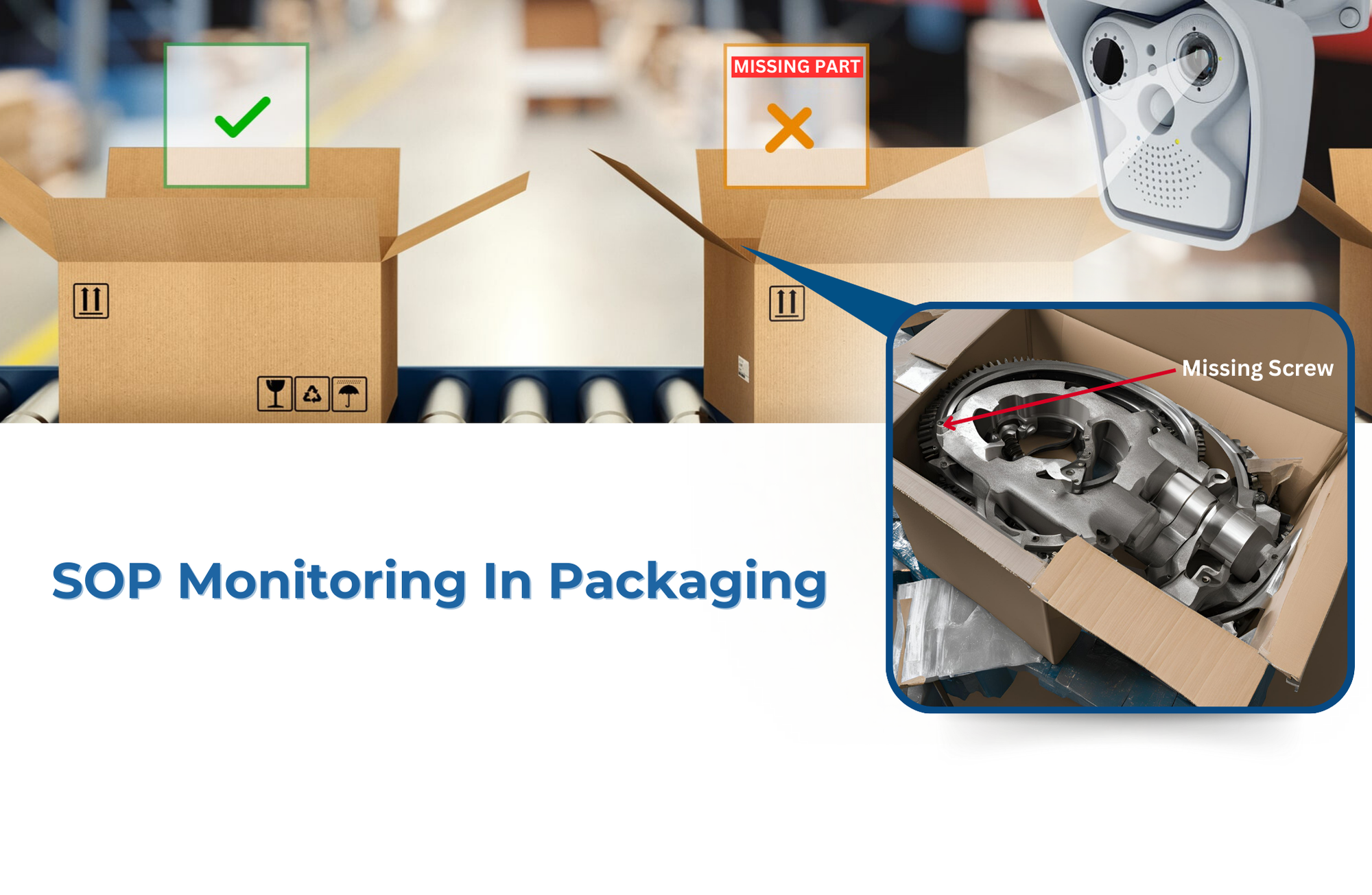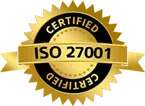Packaging and Assembly Line SOP monitoring using camera and vision system
Published on: Oct 17, 2024

Written by: Soumen das
SOP Monitoring in Packaging Lines Using Machine Vision Systems: Detecting Missing Parts and Components
In industries that rely on complex assemblies, such as machinery manufacturing, appliance production, electrical components, and furniture, ensuring that all parts and components are correctly packaged before shipment is crucial. Missing even a small part during packaging can result in customer dissatisfaction, delays, or costly rescheduling for installers. For instance, when an installer arrives at the customer's location and discovers missing parts, the entire installation process might need to be postponed, resulting in lost time, additional expenses, and inconvenience for both the customer and the installer.
To avoid these issues, manufacturers are increasingly turning to automated inspection systems using machine vision technology. These systems monitor packaging activities in real time, ensuring that every component is included and packaged correctly. By implementing machine vision systems in packaging lines,
companies can not only prevent missing components but also improve the overall accuracy and efficiency of their packaging processes.
In this article, we will explore how machine vision systems are used to monitor Standard Operating Procedures (SOPs) in packaging lines to detect missing parts and components. We will also discuss the benefits of these systems for various industries, including manufacturing, appliances, electronics, and furniture, where correct assembly and fitting are required at the customer’s location.

The Importance of SOP Monitoring in Packaging Lines
In packaging lines, adherence to Standard Operating Procedures (SOPs) is critical to ensure that all parts and components are packaged correctly before shipment. SOPs define the steps required to verify that all parts are included, properly labeled, and sealed before the product leaves the packaging line.
Failing to package all necessary components has several negative consequences:
- Customer Dissatisfaction: Missing parts cause frustration for customers, who may experience delays in assembly or installation.
- Installation Delays: Installers often need to reschedule appointments if key parts are missing, resulting in increased costs and logistical issues.
- Product Returns and Rework: Customers may return incomplete products, leading to additional costs for rework, restocking, and reshipping.
- Damage to Reputation: Repeated errors in packaging can harm the manufacturer’s reputation, affecting customer loyalty and future sales.
To address these challenges, many companies are adopting machine vision systems to monitor packaging lines and automate the inspection process. This ensures that every part is present and accounted for before the product is shipped to the customer.
How Machine Vision Systems Work in Packaging Lines
Machine vision systems are composed of cameras, lighting, and software algorithms designed to inspect products and packaging in real time. In packaging lines, these systems can be used to monitor the presence and correct placement of parts, ensuring that every component is included in the package. Machine Vision AI system can be trained with each item or component or parts to be packaged together. AI can quickly identify each part and item and generate alerts and for missing parts or components.
Here’s how the process typically works:
- Camera Setup: One or multiple cameras are installed at strategic points along the packaging line to capture images or video of the product and its components. These cameras can be placed above or around the packaging area to get a clear view of the parts being packaged.
- Image Capture and Processing: As products move through the packaging line, the cameras capture high-resolution images of the parts and components. These images are then processed by the vision system’s software, which uses advanced algorithms to detect whether all required parts are present.
- Comparison Against SOPs: The system compares the captured images with predefined SOPs that specify the expected components and their placement in the packaging. Any deviation, such as a missing part or improperly placed component, is detected by the system.
- Real-Time Alerts: If the system detects any missing parts, it generates a real-time alert to notify operators. This allows corrective action to be taken immediately, preventing the incomplete product from moving further down the line or being shipped to the customer.
- Evidence and Documentation: The machine vision system can also store images of each packaged product, creating a record of the packaging process. This provides evidence that all parts were included for future reference, which can be useful in the event of customer disputes or compliance audits.
Applications of Machine Vision Systems for SOP Monitoring in Various Industries
Machine vision systems for SOP monitoring and packaging inspection can benefit a wide range of industries, particularly those where complex assemblies are required, and every component is essential for proper installation or use. Below are several industries that can benefit from this technology:
Machinery Manufacturing
In machinery manufacturing, products often consist of numerous components that must be assembled at the customer’s site. Missing even a small part, such as a bolt or gasket, can halt the assembly process, causing delays and increased costs.
How Machine Vision Helps:
- Ensures that all parts required for assembly, such as screws, bolts, fasteners, and mechanical components, are included in the packaging.
- Detects if any components are incorrectly placed, preventing misassembled kits from being shipped.
Appliance Manufacturing
-
Appliances like refrigerators, washing machines, and ovens often require installers to fit multiple components during installation. If key parts, such as brackets or screws, are missing, the installer may need to reschedule the job, leading to customer frustration.
How Machine Vision Helps:
- Verifies that installation kits, including mounting hardware, screws, and hoses, are included in the packaging.
- Monitors for correct labeling and placement of accessories and instructional manuals
Electrical and Electronics Manufacturing
-
In electrical and electronics manufacturing, accurate packaging of cables, connectors, screws, and circuit boards is crucial for successful installation and operation. Missing components can cause delays in system setup or malfunctions.
How Machine Vision Helps:
- Detects missing connectors, cables, or small electronic components during the packaging process.
- Ensures that components are correctly labeled, reducing the chances of installation errors.
Furniture Manufacturing
-
In the furniture industry, products such as tables, chairs, and cabinets require assembly by either the customer or an installer. Missing screws, brackets, or other components can delay assembly and frustrate the customer.
How Machine Vision Helps:
- Automatically verifies that all components, such as screws, nuts, bolts, and wooden pieces, are included in flat-pack kits.
- Detects improper placement or missing hardware, preventing incomplete shipments.
Automotive and Aerospace Industries
-
In the automotive and aerospace industries, packaging lines often involve the handling of small but crucial parts. Missing or mispackaged parts can lead to assembly delays, production stoppages, or safety issues.
How Machine Vision Helps:
- Inspects parts kits to ensure that every component, down to the smallest bolt or gasket, is included.
- Tracks the presence of critical safety components to prevent delays in vehicle or aircraft assembly.

Benefits of Automated SOP Monitoring Using Machine Vision Systems
Automating SOP monitoring and inspection with machine vision systems provides numerous benefits for manufacturers across industries. These benefits include:
1. Real-Time Detection of Missing Parts
One of the most significant advantages of machine vision systems is their ability to detect missing parts in real time. As soon as a component is found to be missing or incorrectly placed, the system generates an alert, allowing operators to correct the issue immediately.
2. Improved Accuracy and Consistency
Machine vision systems provide a level of accuracy and consistency that surpasses human inspection. They can detect even the smallest parts, such as screws or connectors, ensuring that nothing is overlooked. This consistency helps prevent costly errors and delays in product assembly.
3. Increased Efficiency and Throughput
By automating the inspection process, machine vision systems reduce the need for manual checks, allowing packaging lines to operate at higher speeds without sacrificing quality. This leads to increased throughput and overall productivity.
4. Reduced Returns and Rework
By catching errors before products are shipped, machine vision systems help reduce the number of product returns and the need for rework. This not only saves time and resources but also improves customer satisfaction by ensuring that products arrive complete and ready for use.
5. Evidence for Future Reference
Machine vision systems can store images and records of each packaging session, providing evidence that all parts were included. This documentation can be valuable in the event of customer disputes or warranty claims, offering proof that the product was packaged according to SOPs.
Challenges in Implementing Machine Vision for SOP Monitoring
While machine vision systems offer significant benefits, there are some challenges associated with their implementation, including:
1. Variability in Products and Packaging
Products and packaging can vary in size, shape, and color, making it difficult for a single vision system to handle all variations without frequent reconfiguration.
Solution:
- Modern vision systems incorporate machine learning algorithms that allow them to adapt to variations in product and packaging designs. These systems can be trained to recognize different components, ensuring accurate inspections across various product lines.
2. Environmental Conditions
Lighting, temperature, and vibrations on the production floor can affect the performance of machine vision systems.
Solution:
- Controlled lighting and proper vibration damping can improve image quality and ensure reliable inspection results in challenging environments.
3. Cost of Implementation
The initial investment in machine vision technology can be significant, particularly for small manufacturers.
Solution:
- The long-term savings generated by reduced errors, increased efficiency, and fewer returns often outweigh the initial investment costs. Additionally, scalable systems allow manufacturers to start with basic setups and expand as needed.
Trends in Machine Vision for SOP Monitoring
AI-Powered Vision Systems
The introduction of AI and ML into machine vision systems enables these systems to become more adaptive and intelligent. By training on large datasets of images, AI-powered systems can learn to recognize even subtle defects, changes in component placement, and product variations. Over time, the system’s performance improves, allowing for more accurate detection of missing parts and components.
Benefits:
- Improved Defect Detection: AI systems are better at identifying complex patterns and can adapt to changing product designs without requiring manual reconfiguration.
- Predictive Maintenance: AI algorithms can also predict potential issues in the packaging process, such as machine wear or material inconsistencies, allowing for preemptive maintenance and reducing downtime.
Edge Computing for Real-Time Processing
Edge computing involves processing data close to the source of data generation, such as on the factory floor itself. For machine vision systems, this means that image processing and analysis occur on-site, reducing latency and providing immediate feedback for real-time corrections.
Benefits:
- Faster Response Times: By eliminating the need to send data to remote servers for processing, edge computing enables faster detection of missing parts and quicker corrective actions.
- Improved Scalability: Edge computing allows manufacturers to scale up their packaging lines without overwhelming central processing resources, making it easier to implement multiple machine vision systems in parallel.
Robotic Integration
Machine vision systems can also be integrated with robotic systems to further automate the packaging process. For example, robots equipped with vision-guided systems can pick and place components into packaging, inspect the placement of parts, and even apply labels, ensuring that every step of the packaging process adheres to SOPs.
Benefits:
- Full Automation: Robotic systems can handle repetitive packaging tasks with high accuracy and consistency, reducing the need for human intervention.
- Real-Time Adjustments: Vision-guided robots can make real-time adjustments to their actions based on the feedback from the machine vision system, ensuring that missing parts or components are immediately addressed.
.png)
The integration of machine vision systems for SOP monitoring in packaging lines is a transformative approach that ensures all components and parts are correctly packaged before shipment. This technology enhances the accuracy, speed, and reliability of packaging processes across industries such as machinery manufacturing, appliances, electronics, and furniture. By detecting missing parts in real time, providing immediate feedback, and maintaining a record of compliance, machine vision systems help manufacturers maintain high-quality standards, reduce errors, and improve customer satisfaction.
As technology continues to advance, manufacturers will benefit from the increasing capabilities of machine vision systems, such as AI-powered inspections, edge computing for real-time processing, and 3D vision systems for enhanced depth analysis. By adopting these solutions, companies can streamline their packaging lines, ensure that every product reaches customers with all necessary components, and maintain a competitive edge in the marketplace.
Machine vision systems are no longer optional for companies that want to ensure efficient packaging operations—they are essential tools for maintaining quality, improving operational efficiency, and staying ahead in the increasingly demanding world of modern manufacturing.

